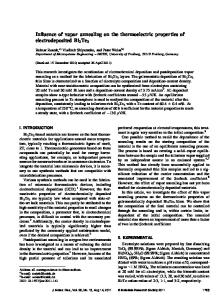First-principles investigations on the thermoelectric properties of Bi 2 Te 3 doped with Se
- PDF / 359,256 Bytes
- 6 Pages / 432 x 648 pts Page_size
- 86 Downloads / 623 Views
First-principles investigations on the thermoelectric properties of Bi2Te3 doped with Se Liwen F. Wan and Scott P. Beckman Department of Material Science and Engineering, Iowa State University, Ames, IA 50010, U.S.A. ABSTRACT In this work, the thermoelectric properties of Se-doped Bi2Te3 are examined using firstprinciples density functional theory and semi-classical Boltzmann transport theory. Placing a single Se atom on the 3a Wyckoff position lowers the unit cell energy by approximately 3.6 eV, compared to the 6c Te position. The electronic structure of Bi2Te3 has minor changes upon Se doping. At carrier concentration of 1019 cm-3, the optimal thermopower, S, is obtained as 207 and 220 μV/K for n-type and p-type doping, respectively. Unlike the thermopower, the power factor, S2σ/τ, is highly anisotropic for the in-plane and cross-plane conduction. At carrier concentrations of 1019 cm-3, the best power factor is predicted to be around 1.05 and 1.4×1011 W/m·s·K2 for ntype and p-type doping, respectively. INTRODUCTION Bi2Te3 is a well-known thermoelectric (TE) material that can be used near room temperature [1-3]. The potential energy conversion efficiency of a typical TE material is measured by the dimensionless figure of merit, ZT = S2σT/κ, where S is the Seebeck coefficient (also referred to as thermopower), T is the operating temperature, σ and κ are the electrical and thermal conductivity, respectively. The thermal conductivity is further divided into the lattice contribution, κl, and the electronic contribution, κe, where κe scales almost linearly with σT. In practice, it is extremely challenging to obtain a large ZT value because the material properties are interrelated and tend to counter one another. For example, a material with a high Seebeck coefficient usually has fewer free carriers, which means a low electrical conductivity is often exhibited. On the other hand, increasing the electrical conductivity also increases the electronic contribution to the thermal conductivity. Ultimately, the pragmatic approach is to search for heavily doped semiconductors that also have a large σ/κ ratio. The Bi2Te3 crystal family has been intensively studied, and ZT values greater than 1 are reported in the literature [3-5]. Many scientific attempts have been made to improve their TE performance by controlling the thermal conductivity [6-13]. At the atomic scale, it is shown that the κl can be greatly reduced by introducing point defects, which help to scatter phonons [7,8]. In addition, by forming long-ranged periodic structures, such as superlattices, the TE performance may also be enhanced [11,12]. Here we examine the effect of Se doping on the TE properties of Bi2Te3, by introducing a single Se atom to the hexagonal Bi2Te3 unit cell. The electronic structure of Se-doped Bi2Te3 is determined from first-principles density functional theory (DFT) [14,15]. Combining DFT with the semi-classical Boltzmann transport theory [16,17], the TE behavior is discussed in relation to the free carrier concentration and temperature.
23
Data Loading...











